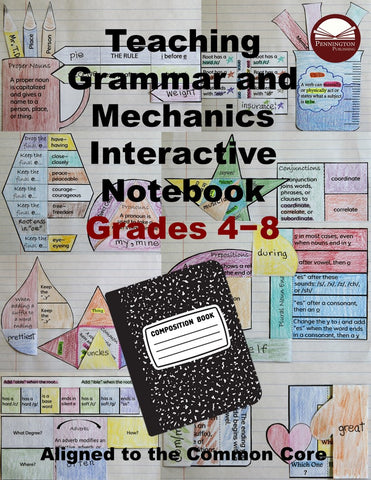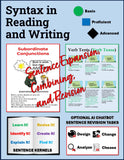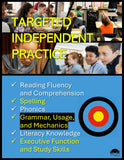
Grammar, Usage, and Mechanics Interactive Notebook Grades 4-8
Need a no-prep interactive grammar notebook to teach review and grade-level grammar and mechanics standards? With Cornell Notes, foldables, tons of online links, practice worksheets, and biweekly tests? Plus, interactive Google slides!
All program components are digital downloads (no print books).
Quick Video Preview Click to Preview the Entire Book
*Rigorous assessment-based instruction. Each of the 64 lessons provides a separate teacher's guide and student lessons for a full year of grammar and mechanics instruction. A lesson includes these instructional components: Cornell Notes Mechanics and Grammar Lesson with links and Resources and corresponding student lessons (printable PDFs and Google slides); Cartoon Response, Writing Application, and 3D Graphic Organizer (PDFs)
*Complete alignment to the Common Core Standards with built-in review. Lessons include assessment-based instruction in all grades 4-8 grammar and mechanics (language conventions) Standards with special emphasis on the Progressive Skills Review Standards grades 3–8.
*Biweekly unit tests (printable PDFs and Google forms) including definition, identification, and application (answers included) 20–25 minutes to complete
All program components are digital downloads (no print books).
Quick Video Preview Click to Preview the Entire Book
*Rigorous assessment-based instruction. Each of the 64 lessons provides a separate teacher's guide and student lessons for a full year of grammar and mechanics instruction. A lesson includes these instructional components: Cornell Notes Mechanics and Grammar Lesson with links and Resources and corresponding student lessons (printable PDFs and Google slides); Cartoon Response, Writing Application, and 3D Graphic Organizer (PDFs)
*Complete alignment to the Common Core Standards with built-in review. Lessons include assessment-based instruction in all grades 4-8 grammar and mechanics (language conventions) Standards with special emphasis on the Progressive Skills Review Standards grades 3–8.
*Biweekly unit tests (printable PDFs and Google forms) including definition, identification, and application (answers included) 20–25 minutes to complete
*Clear directions with the same instructional procedures for each lesson. Perfect for both the beginning teacher, expert grammarians, and substitutes.
*Online links to songs, posters, sentence diagrams, and more
*Diagnostic Grammar, Usage, and Mechanics Assessments (printable PDFs and Google forms) with 77 remedial worksheets (printable PDFs and Google slides), each with a formative assessment... plus, an Assessment Master Matrix for progress monitoring (printable PDFs and Google sheets)
*Final exam covering all 64 lessons (Google forms and sheets)
*Simple and fun 3D graphic organizers from Tangstar (the best on the web) with clear directions and less mess and interactive Google slides with a fun, problem-solving secret agent theme with drop-and-drag, audio, and fill-in the text box activities
*Minimal prep and correction. Teachers don’t have to create their own INB for student make-up work. Print three student pages per lesson, set out the crayons, scissors, and glue (or tape), and your students write down examples and annotate on the Cornell Notes in their comp books or spiral notebooks. You display the teacher pages, read the lesson, and lead the discussion. Everything to make you the expert grammarian is included.
*Flexible curriculum. Teachers choose what works for their schedules and class time. Complete all or part of each lesson. Mix and match the paper INB and digital activities.
Check out my blog article here on Ten Reasons to Use Interactive Notebooks.
We Also Recommend




